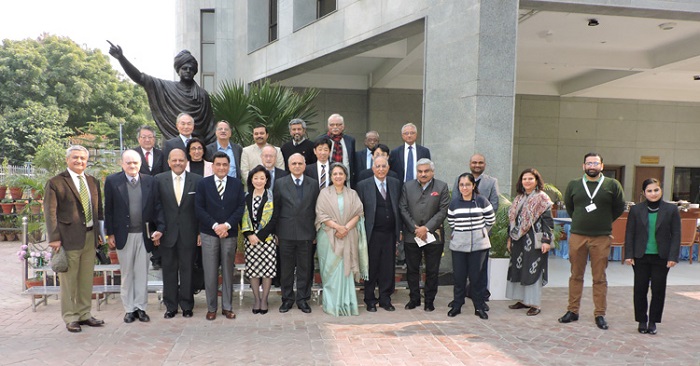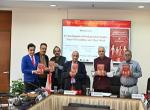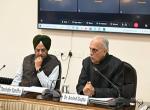The Vivekananda International Foundation (VIF) organized a seminar on 6th February 2019 for a senior delegation visiting from Japan Institute of National Fundamentals (JINF) led by President Yoshiko Sakurai. The seminar was attended by senior retired diplomats and strategic experts in New Delhi. The discussion focused on the theme of India-Japan Relations in an Uncertain Era - with two sessions dedicated to 'Assessing the Regional Situation from India and Japan's Perspective' and 'India-Japan Defense and Security Cooperation'. A special session on ‘India-Japan Economic and Technological Cooperation’ was organized in collaboration with Confederation of Indian Industry (CII) on 5th February 2019. It saw participation by senior executives from Indian industry.
The deliberations on both the days covered a wide spectrum of issues, and a number of recommendations were made. Both sides mentioned that the India-Japan bilateral partnership held great importance for their respective governments and countries. While, there were many structures for bilateral cooperation, there was need to increase the strategic content in those structures. Some of the salient points raised are listed in following paragraphs.

Opacity of China’s Ambitions
Both countries raised serious misgivings on the ‘Peaceful Rise’ and alleged non-hegemonic aspirations of China. While China has been the biggest beneficiary of the US-led global order, it has strong ambitions and its own interests now. Whether it can push through with those ambitions will depend on the continued strength of its economy.
Shaping Indo-Pacific Agenda
Currently, after three intergovernmental quad talks, a wide agenda for cooperation has been identified ranging from connectivity, sustainable development, counter-terrorism, non-proliferation to maritime and cyber security. The discussion identified additional need for more emphasis on softer aspects of security such as HADR, energy security, digital connectivity etc. which are important for all countries in the region. Eventually, with time a more focused strategy can be expected to evolve.
Managing Relations with China
China is a major component of the regional economic and strategic calculus. This requires an astute management of relations with China. The big dilemma is prevailing upon the Chinese to play a constructive role in the Indo-Pacific, while simultaneously discouraging efforts of undermining its rules-based order. After summit-level talks in 2018, India’s efforts at a ‘reset’, and Japan’s efforts ‘a new start’ in its relations with China can be considered steps in that direction.
Upgrading Quad Talks
The quadrilateral talks should be upgraded to the ministerial level, and eventually to summit talks.
Chinese Belt and Road Initiative (BRI)
The Indian side explained its refusal to endorse Chinese BRI due to its strong concerns on BRI violating Indian sovereignty and now increasing debt burden of BRI recipient countries. While the Maritime Road has gained maximum attention, there is need to have more understanding on the strategic implications of the Land Belt that cuts across Central Asia, Eurasia and West Asia. The Japanese side also conveyed their apprehensions towards the Asian Infrastructure Investment Bank (AIIB) due to its governance standards and lack of financial transparency.
Malabar Exercise – A Linchpin?
Malabar Exercise should not be looked upon as the linchpin of Quad or the de facto starting point of a defense alliance. With Indo-Pacific covering a wide geographical expanse, the Quad countries should lay larger focus on strengthening maritime governance, maritime domain awareness (MDA), humanitarian assistance and disaster relief (HADR) etc. The prime agenda, the main focus has to be on restoring order and a sense of strategic certainty where countries have to play by the accepted norms and rules.
The Concept of ‘Inclusivity’
The Indian side explained that the focus on ‘inclusivity’ as one of the principles indicates the desire to reinforce a strong normative security architecture that is based on a free, open and rules-based international order. Prime Minister Modi’s speech at Shangri-La needs to be looked at from that context. Thus, all countries that ascribe to those principles are welcomed.
Japan-China Third Country Cooperation
The Japanese side explained that while Japan and China agreed on third country cooperation during Prime Minister Abe’s visit to China in October 2018, Japanese participation is not unconditional or an endorsement of Chinese BRI. The four conditionalities are openness, transparency, economic viability and financial soundness of the receiving countries. Also, though 52 MoUs were signed between Japanese and Chinese private companies, many of these projects are in Southeast Asia where Japan already has significant investment.
Asia Africa Growth Corridor (AAGC)
Both sides discussed reasons why the AAGC has been unable to take-off. Emphasis was laid on the need to jointly identify suitable projects. Also, the joint US$ 15 million fund that has been created was deemed too meagre to make an impact.
ASEAN Centrality
A common principle mentioned by all Quad countries in their official statements after the three intergovernmental talks between India, Japan, US and Australia is ASEAN centrality in the Indo-Pacific. There should be greater engagement with ASEAN member countries to strengthen Indo-Pacific agenda.
Russia
India and Japan can take a lead role in engaging Russia under the Quad framework as it is indispensable in the regional security calculus.
Japan’ Limitations on Defence Exports
Despite, Japan being acknowledged as a “privileged partner” in the Make in India initiative, Japan does not bid for any Indian defence project. Japan’s experience in defence exports is negligible. The Japanese thus prefer the G2G way. The defence component for Japanese companies is only 3-4 per cent of their entire business. They are not globally competitive (on price) because they do not export and also have no experience of professional tendering. At times, there are further hassles because Japan requires clearance for certain technologies which have been jointly developed with the US (to export to third country). Japan also has the same (military) systems for domestic use and exports which are highly sophisticated systems. There are no variants for exports as major defence exporters such as Russians and American have. This creates further misgivings on Japanese side on sharing technologies. Indian Armed Forces require semiconductor technologies, lithium ion batteries, laser diodes, etc., which the Japanese have a very visible advantage in.
Understanding Each Other’s Security Calculus
Both sides agreed that there should be more frequent exchanges of views on each other’s regional security perspectives. Japanese side conveyed its keen interest for India to cooperate more on international security issues. Also, many speakers mentioned the large latent potential for cooperation between India and Japan in many multilateral security fora on wide spectrum of issues such as cyber security, preventing weaponization of space, the Indian Ocean Naval Symposium (IONS) and Western Pacific Naval Symposium (WPNS), arms control etc.
5G
While the commercial implications of 5G are well-known in the era of Big Data and AI, the strategic implications must not be ignored. There is growing Chinese investment and contribution in nearly every IT product development worldwide. In this scenario, there has to be balance of power that may not necessarily involve military instruments of policy. The US-China trade war is essentially a fight on Chinese attempts at digital hegemony.
Limitations of Top-Bottom Private Investment
Both sides highlighted that there was a certain divergence between government and private sector on economic issues. However, there should be continued efforts at increasing India-Japan connectivity and improving Indian infrastructure that will help change private sector mindset in both countries.
Strengthening Principles of International Cooperation through UNSC
In this era of strategic uncertainty, India and Japan need to reinforce principles of international cooperation under the aegis of the United Nations that has been weakened by major powers. There needs to be more outreach to partners in Africa, Asia, Europe and Latin America. The UN Security Council (UNSC) reforms need to be mentioned into every document issued under the Indo-Pacific Security framework.
India-Japan Cooperation in Third Countries
A case was made for Japan to increase its investments in India, as these investments would inevitably have a spill over effect in the neighbouring countries. There have been discussions on India and Japan working together in Hambantota, Sri Lanka on an LNG plant, but Japan has been unable to identify any private company to invest into Sri Lanka. India and Japan can cooperate in building ports in Indian Ocean such as in Sabang or Chabahar.
TPP-11
A suggestion was made for India’s participation in the new Comprehensive and Progressive Agreement for Trans-Pacific Partnership (TPP-11) that is now led by Japan. Being largely a service economy, India stands to benefit from the TPP-11 format.
India-Japan Economic and Technological Cooperation
Due to lack of Indian integration into East Asian supply chains, Japan’s imports from India are a fraction as compared to those from China. Yet though India-Japan bilateral trade has seen a declining trend, there is optimism in the growing investment that has led Japan to emerge as one of the top three foreign direct investors in India. The Modi administration has accorded great priority to Japanese investment by initiative such as “Japan-Plus”, "Advanced Model Single Window” to streamline administrative procedures in Central and State Governments of India etc. However, there has not seen an increase in high-tech industries barring automobiles. Yet, the complementary strengths in human resource and market size of India and financial resources and technology of Japan offer great potential for building cooperation in new areas such as semiconductors, AI, IoT, new energy etc.








Post new comment